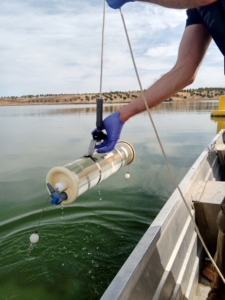Water monitoring: an important activity
Periodic water monitoring is important to assess water quality.
Blooms of toxic cyanobacteria threaten aquatic ecosystems. Therefore, monitoring is important to predict and manage these events.
The monitoring of water bodies begins with planning, obtaining geographical information of the study area, defining sample frequency, selecting methods, and finally organizing the sampling campaigns.
The sampling team should be properly equipped with protection gear. GPS is commonly used to register the sampling points, samples are stored in plastic and glass bottles, phytoplankton is collected with nets, and multiparameter probes are used to measure temperature, pH, and other water quality parameters.

Water sampling Alqueva reservoir, Portugal. Source: TOXICROP project
Besides the data collected in the field, other analysis needs to be carried out in laboratories. The physical, chemical, and biological parameters of the water are always measured as these are essential to assess water quality.

Monitoring campaign in Alqueva reservoir, Portugal. Source: TOXICROP project
The World Health Organization (WHO) provides recommendations for the monitoring of toxic blooms, such as evaluation of foam formation, color, transparency, surrounding fauna and flora, and phosphorus and nitrogen concentrations. In the event of a suspected cyanobacterial bloom, microscopic analysis with identification and counting of colonies and determination of cyanotoxins should be carried out. Cyanobacteria biovolumes above 0.3 mm3/L in water trigger the alert for the possible contamination of drinking water. WHO also defined threshold values for cyanotoxins concentrations.
It is essential to promote research, development and innovation in techniques for the detection, quantification, and control of toxins and cyanobacteria.


